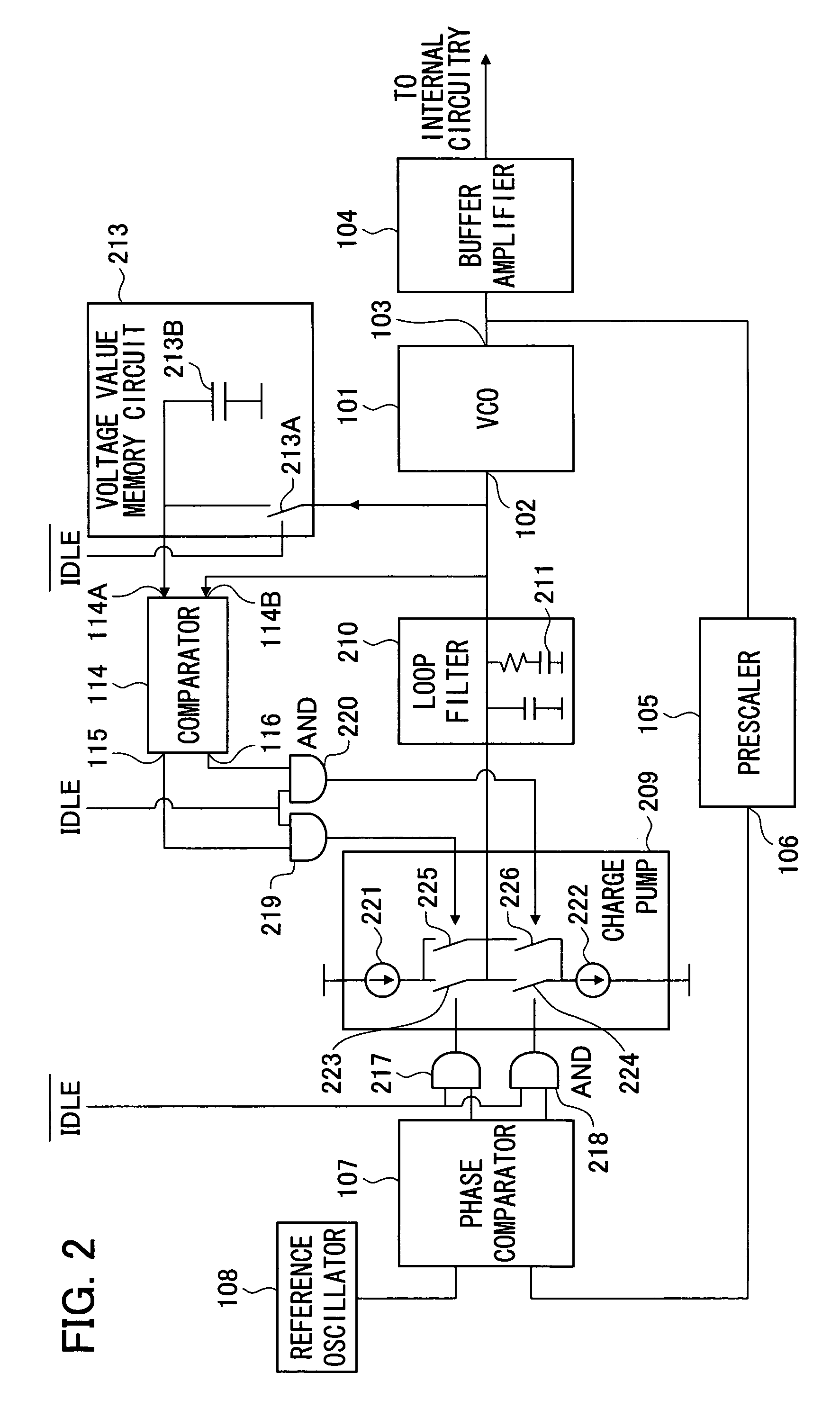PLL circuit having reduced pull-in time
a technology of pull-in time and circuit, which is applied in the direction of automatic control, electrical equipment, etc., can solve the problems of reducing power consumption, affecting the speed of the system, and taking a long time to produce a stable frequency, so as to reduce the power consumption of the system, the effect of simple structur
- Summary
- Abstract
- Description
- Claims
- Application Information
AI Technical Summary
Benefits of technology
Problems solved by technology
Method used
Image
Examples
example 1
[0061]FIG. 2 is a block diagram illustrating the structure of a PLL circuit which represents example 1 of the present invention. As shown in the figure, The PLL circuit of the present example includes a circuit containing a switch 213A and a capacitor 213B as the voltage value memory circuit 213. The capacitor 213B is located at a position equivalent to that of the capacitor 211 in the loop filter 210. The capacitor 213B is therefore a part of the loop filter 210 while the PLL is in operation.
[0062]Whether the phase difference signal or the comparison signal is fed to the charge pump 209 is controlled in accordance with whether the PLL circuit is in a normal operation mode (ON) or in a standby mode (OFF). Thus there are provided AND circuits 217, 218, 219, 220 to the phase difference signal output of the phase comparator 107 and the comparison signal output of the comparator 114. In addition, in the PLL circuit of the present example the charge pump 209 is constructed of: a source p...
example 2
[0067]FIG. 3 is a block diagram illustrating the structure of a PLL circuit which represents example 2 of the present invention. As shown in the figure, the present example differs from example 1 above in the voltage value memory circuit 313; otherwise, example 2 has the same structure as example 1.
[0068]The voltage value memory circuit 313 of the present example includes an A / D converter 327, a D / A converter 328, and a memory 329. The A / D converter 327 is connected to the loop filter 210 and the memory 329. The A / D converter 327 converts an analog signal input of the loop filter 210 to digital for an output to the memory 329 where the output is recorded. The D / A converter 328 is connected to the memory 329 and the comparator 114. The D / A converter 328 converts a digital signal stored in the memory 329 to an analog signal for an output to the comparator 114.
[0069]The voltage value memory circuit 313 operates in the same fashion as the voltage value memory circuit 113 (see FIG. 1) as...
example 3
[0071]FIG. 4 is a block diagram illustrating the structure in and around a charge pump of a PLL circuit which represents example 3 of the present invention. As shown in the figure, in the present example, the output signals of the phase comparator and the comparator are coupled using a multiplexer, which reduces the number of current control switches for the charge pump as compared to examples 1, 2. The PLL circuit of the present example differs from those of examples 1, 2 in that the charge pump has less internal current control switches than in examples 1, 2 and that the output signals of the phase comparator and the comparator are coupled using a multiplexer; otherwise, the present example has the same structure as examples 1, 2.
[0072]The charge pump 409 in the PLL circuit of the present example is constructed of a source power supply, or current supplier, 421; a sink power supply, or current drawer, 422; and switches 423, 424 which are turned on / off by a signal from either the p...
PUM
 Login to View More
Login to View More Abstract
Description
Claims
Application Information
 Login to View More
Login to View More - R&D
- Intellectual Property
- Life Sciences
- Materials
- Tech Scout
- Unparalleled Data Quality
- Higher Quality Content
- 60% Fewer Hallucinations
Browse by: Latest US Patents, China's latest patents, Technical Efficacy Thesaurus, Application Domain, Technology Topic, Popular Technical Reports.
© 2025 PatSnap. All rights reserved.Legal|Privacy policy|Modern Slavery Act Transparency Statement|Sitemap|About US| Contact US: help@patsnap.com



